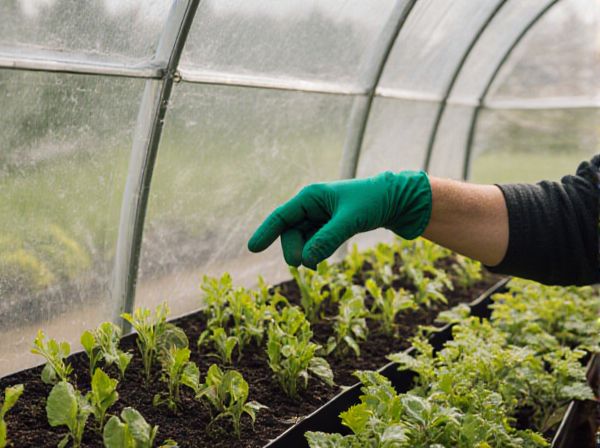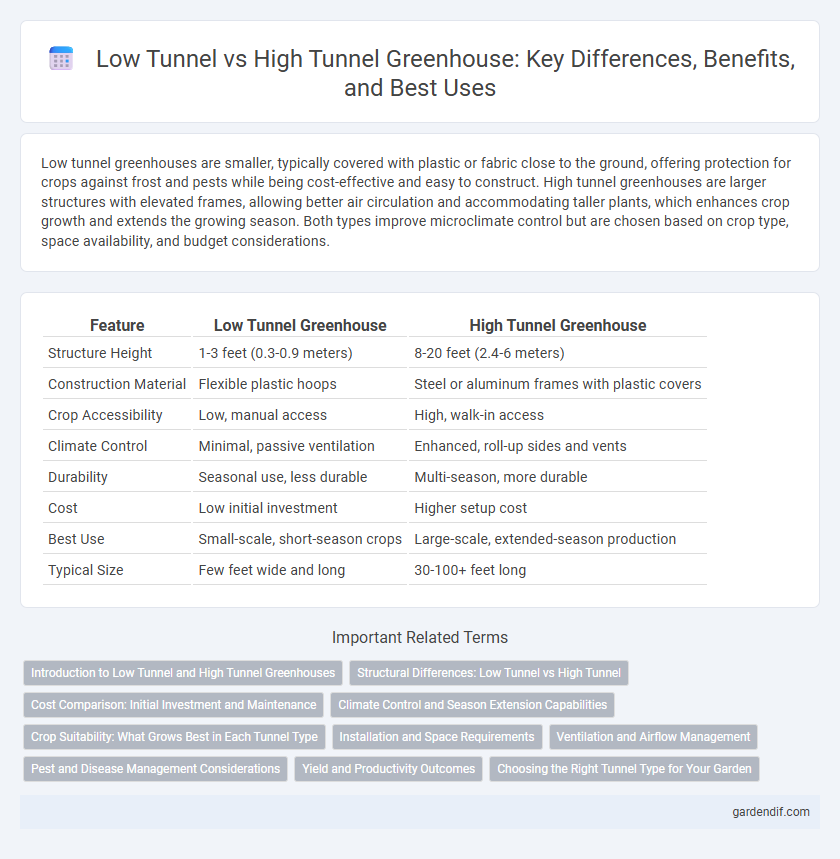
Low Tunnel Greenhouse vs High Tunnel Greenhouse Illustration
Low tunnel greenhouses are smaller, typically covered with plastic or fabric close to the ground, offering protection for crops against frost and pests while being cost-effective and easy to construct. High tunnel greenhouses are larger structures with elevated frames, allowing better air circulation and accommodating taller plants, which enhances crop growth and extends the growing season. Both types improve microclimate control but are chosen based on crop type, space availability, and budget considerations.
Table of Comparison
| Feature | Low Tunnel Greenhouse | High Tunnel Greenhouse |
|---|---|---|
| Structure Height | 1-3 feet (0.3-0.9 meters) | 8-20 feet (2.4-6 meters) |
| Construction Material | Flexible plastic hoops | Steel or aluminum frames with plastic covers |
| Crop Accessibility | Low, manual access | High, walk-in access |
| Climate Control | Minimal, passive ventilation | Enhanced, roll-up sides and vents |
| Durability | Seasonal use, less durable | Multi-season, more durable |
| Cost | Low initial investment | Higher setup cost |
| Best Use | Small-scale, short-season crops | Large-scale, extended-season production |
| Typical Size | Few feet wide and long | 30-100+ feet long |
Introduction to Low Tunnel and High Tunnel Greenhouses
Low tunnel greenhouses, typically constructed with flexible plastic covers over low hoops, create a microclimate ideal for season extension and frost protection in small-scale gardening. High tunnel greenhouses, larger and with taller structures, provide superior ventilation and space, allowing for longer crop cycles and increased yield in commercial farming. Both systems enhance plant growth by controlling temperature, humidity, and light, but differ in scale, cost, and crop suitability.
Structural Differences: Low Tunnel vs High Tunnel
Low tunnel greenhouses feature a smaller, half-circle shape typically supported by hoops made of plastic or metal, offering a compact structure ideal for low-height crops and limited space. High tunnel greenhouses exhibit a taller, peaked frame constructed with sturdy metal or wood, allowing extensive vertical growth and better ventilation, suitable for larger-scale farming. Structural differences impact crop choices, microclimate control, and ease of access within these greenhouse types.
Cost Comparison: Initial Investment and Maintenance
Low tunnel greenhouses typically have a lower initial investment cost, ranging from $1 to $3 per square foot, due to simpler materials like plastic hoops and polyethylene covers. High tunnel greenhouses, with costs between $3 and $10 per square foot, require more robust frames and durable covering materials, increasing both initial expenses and ongoing maintenance. Maintenance for low tunnels is generally minimal, but high tunnels demand regular inspections and repairs to structural elements and coverings, contributing to higher overall upkeep costs.
Climate Control and Season Extension Capabilities
Low tunnel greenhouses provide localized microclimate control ideal for protecting crops from frost and wind, extending growing seasons by several weeks in early spring and late fall. High tunnel greenhouses offer enhanced climate regulation with better ventilation options and frost protection, facilitating longer season extension and higher crop yields. Both structures improve temperature moderation but high tunnels deliver superior control for temperature, humidity, and airflow management.
Crop Suitability: What Grows Best in Each Tunnel Type
Low tunnel greenhouses are ideal for growing cool-season crops such as lettuce, spinach, and radishes due to their ability to maintain moderate temperatures and protect against frost. High tunnel greenhouses support a wider range of crops including tomatoes, peppers, and cucumbers, benefiting from higher vertical space and improved air circulation for heat-loving plants. Selecting the appropriate tunnel type enhances crop yield by matching plant temperature and space requirements.
Installation and Space Requirements
Low tunnel greenhouses require minimal installation effort and occupy less space, making them ideal for small-scale or backyard gardening. High tunnel greenhouses demand more extensive setup, including sturdy framing and anchoring, and cover a larger area suitable for commercial production. Both types optimize crop protection, but installation complexity and spatial footprint greatly influence the choice.
Ventilation and Airflow Management
Low tunnel greenhouses offer limited ventilation options due to their compact size and low structure, relying primarily on manual opening of end walls or side flaps to promote airflow. High tunnel greenhouses feature enhanced ventilation systems, including adjustable sidewalls and ridge vents that facilitate superior air circulation, temperature control, and humidity regulation. Efficient airflow management in high tunnels significantly reduces disease risk and improves crop growth by maintaining optimal growing conditions.
Pest and Disease Management Considerations
Low tunnel greenhouses offer enhanced pest and disease control through their enclosed structure, limiting pest entry and reducing exposure to external pathogens. High tunnel greenhouses, while larger and more ventilated, require vigilant monitoring and integrated pest management strategies to address increased airflow that may introduce pests and diseases. Selecting between low and high tunnels depends on balancing the ease of pest exclusion versus the need for airflow management to minimize disease incidence.
Yield and Productivity Outcomes
Low tunnel greenhouses typically enhance yield by providing targeted protection for smaller crops, resulting in quicker crop cycles and efficient space utilization, ideal for early-season growth. High tunnel greenhouses support higher productivity with larger growing areas and improved climate control, enabling extended growing seasons and greater plant density. Studies show high tunnels often achieve 20-30% higher yield per square foot compared to low tunnels due to optimized environmental conditions and crop diversity.
Choosing the Right Tunnel Type for Your Garden
Low tunnel greenhouses offer compact protection ideal for small-scale gardens and delicate crops, maintaining higher humidity and warmth close to the plants. High tunnel greenhouses provide larger growing space with improved air circulation, suitable for extensive crop production and facilitating easier access for maintenance. Selecting between low and high tunnels depends on garden size, crop type, and climate adaptability to optimize growth and yield.
Low Tunnel Greenhouse vs High Tunnel Greenhouse Infographic

 gardendif.com
gardendif.com